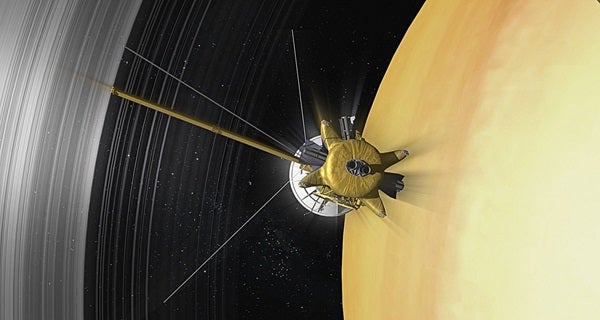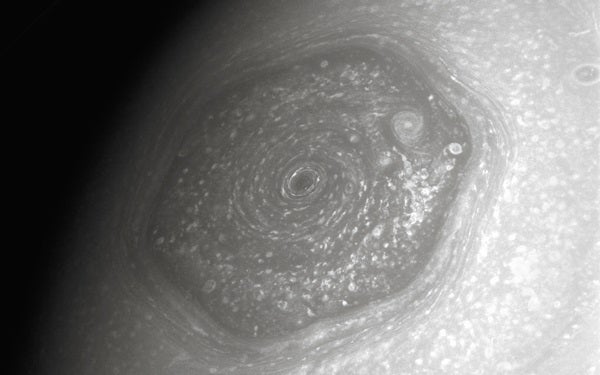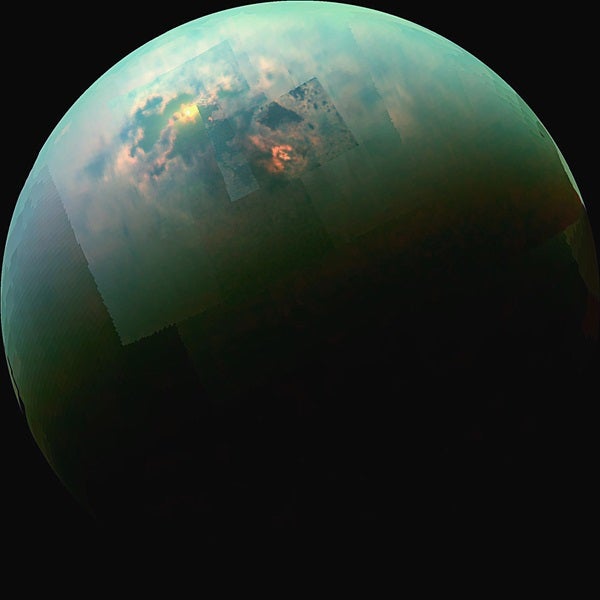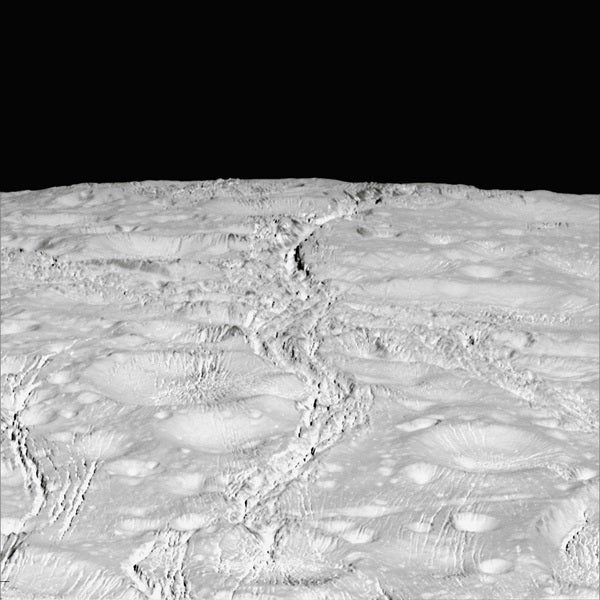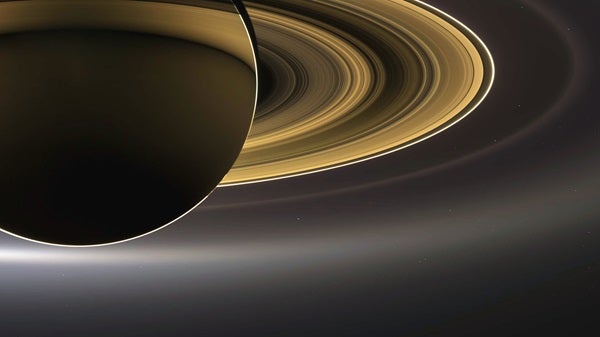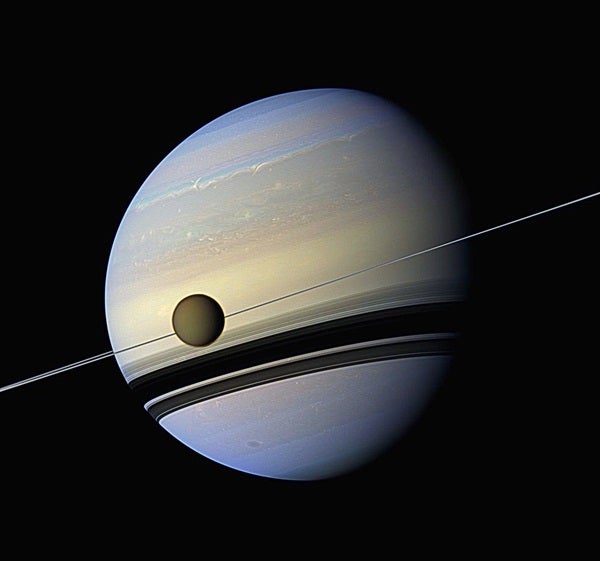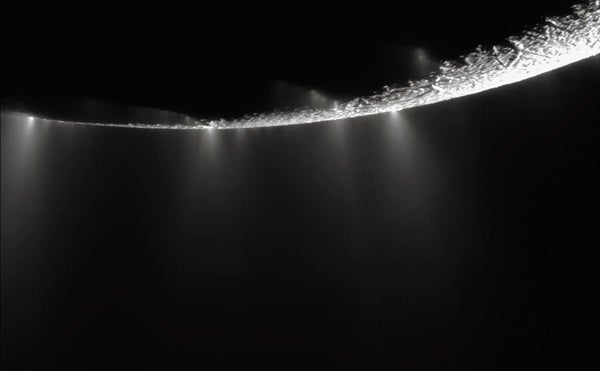Time is almost up for the Cassini mission to Saturn.
Late in November 2016, the spacecraft began a series of steep orbits above Saturn’s poles, just outside the planet’s main rings. These 20 polar orbits prepare the craft for its swan song: a series of daredevil close orbits inside the rings, ending with a death dive into the planet in September 2017. That will mark the end of an extended mission, but give the probe enough time to witness Saturn’s May 2017 solstice, when the planet’s tilt exposes its far-northern latitudes to direct sunlight.
Cassini still has much to accomplish in the meantime. The Grand Finale — although technically still part of the Solstice mission — will feel like a whole different mission. Cassini will be much closer to Saturn, taking some big risks to do up-close science, as low as 1,056 miles (1,700 kilometers) above the clouds. The spacecraft’s final months will reveal more detail about Saturn’s rings, its weather, and the gas giant’s internal structure. As scientists monitor the slow change of seasons, the solstice will light Saturn, its iconic ring system, and its icy moons from a whole new angle, revealing features that may have been previously hidden by light and shadow.
Cassini will get a last look at some of the strangest weather as it flies over the poles of a world dominated by immense storms, including Saturn’s famous northern hexagon. Clouds swirl around the north pole in an unusually geometric formation, bound by 200 mph (322 km/h) jet streams. A monster hurricane rages at the center, with 340 mph (547 km/h) winds at the edges and an eye 50 times larger than that of the largest hurricane ever recorded on Earth.
Researchers are still trying to understand why the jet stream’s path forms a symmetrical hexagon and why its corners rotate at roughly the same speed as the northern hemisphere itself. “We’d really like to understand what keeps it stable in that configuration,” says Cassini project scientist Linda Spilker.
Voyager 1 first spotted the hexagon on its 1980 flyby, but Cassini stayed in orbit through the long saturnian winter to watch the storm with its infrared and visual instruments from a farther vantage point. The current path above Saturn’s poles will provide a better look at the hexagon, the northern hurricane, and a corresponding, slightly smaller hurricane near the south pole.
Prelude to the Grand Finale
The polar orbits seem like a dress rehearsal for the faster-paced, riskier final days of the mission. Cassini is orbiting Saturn at the same inclination it will have during the Grand Finale, but at a more prudent distance. “It’s basically a chance to get a good view of the outermost main ring system and do some initial science before we hop into the final 22 orbits,” says Spilker.
In April, the spacecraft will shift into a much closer orbit and begin the Grand Finale. At its lowest point, Cassini will pass inside Saturn’s innermost rings, skimming the top of the gas giant’s atmosphere. It will take Cassini just six or seven days to make each Grand Finale orbit, making the more distant multiple-week orbits of the main mission look positively leisurely by comparison.
Grand Finale will be some dangerous flying in a whole new environment for Cassini. “We’ve got dust on our left; we’ve got atmosphere on our right,” says Cassini project manager Earl Maize of NASA’s Jet Propulsion Laboratory.
To enter that daring close-up orbit, Cassini will get a push from Titan. It will make a final flyby of the giant moon April 22, 2017, and Titan’s gravity will give the spacecraft enough of a nudge to change its velocity and shift it into a closer orbit. It will be the final step in a complicated seven-year dance between Cassini and Titan.
The Solstice mission required Cassini to do a lot of maneuvering with relatively little propellant. The extension more than doubled Cassini’s time in orbit, but it had only about a fifth of its original propellant remaining as of late 2010. To meet the scientific goals of 200 researchers from 17 countries, Cassini needed to achieve a series of orbits at different inclinations and distances.
Changing orbits requires a change of velocity, what engineers refer to as delta-V, and achieving a delta-V typically requires the spacecraft’s engines to burn propellant. To conserve fuel, Cassini instead used its thrusters to put the spacecraft in the right spot with relation to Titan and let the moon’s gravity supply the rest of the delta-V to push Cassini into a new orbit.
Starting in spring 2015, a series of engine burns set up the Titan flybys that helped shift the spacecraft from its old equatorial orbit to its current orbit over Saturn’s poles. The last of the major burns was completed in mid-2016, much to the relief of mission planners. “We’ve been almost empty on the main engine for some time, and it’s been very uncertain whether we were going to go blazing into the Grand Finale or limping in,” says Maize. His team opted to use the spacecraft’s smaller thrusters for the final maneuvers, to avoid the risk of the main engine running out of fuel midburn.
It took mission planners two years to plot the series of Titan flybys that would help Cassini meet as many of the science team’s diverse goals as possible. “What happens is we lay out a trajectory, essentially the path of the spacecraft, and we have some course objectives,” Maize says. “We want to have some orbits that are in the equatorial plane and some that are highly inclined because they provide different opportunities: the polar observations of Titan, and in the equatorial plane we get the icy satellites.
“Each of the science teams provides a lot of science desires, and the trajectory guys go off and revise the trajectory.”
Among the last of those science goals is a puzzle that has vexed researchers for more than a decade: How long is a day on Saturn?
It’s hard to measure the rate of Saturn’s rotation because the gas giant’s bands and layers of clouds move at different speeds. Scientists in the 1980s had estimated the planet’s rotation rate at 10.66 hours, based on periodic radio emissions from the interior, called Saturn Kilometric Radiation. However, Cassini revealed a more complicated story.
“We thought from Voyager we knew that rotation rate,“ says Spilker, also a veteran of the Voyager missions. “We get there with Cassini, and we find out this radio signal from the planet is not coming from the interior, but rather possibly from the auroral regions.” Saturn Kilometric Radiation turned out to be two different emissions coming from the gas giant’s poles. And each indicated a different period for its hemisphere: 10.6 hours for the northern and 10.8 hours for the southern.
The northern hemisphere’s rotation started slowing down just after the August 2009 equinox, while the southern hemisphere sped up. Seven months after the equinox, in March 2010, the two hemispheres’ speeds matched briefly at about 10.67, but now the northern hemisphere’s rotation period is slightly longer than the southern.
The seasonal variation may be related to the Sun’s interaction with Saturn’s magnetic field, and in fact, that field may be masking the interior’s real rotation rate. Unlike Earth’s axis, Saturn’s axis seems to line up with its magnetic poles. During the Grand Finale orbits, Cassini will fly low enough to map Saturn’s magnetic field and its gravitational field, looking for clues to the mystery of the gas giant’s rotation rate and inner composition.
The Grand Finale orbits also will give Cassini an up-close look at Saturn’s famous rings, which could shed light on what they’re made of and how they interact with the gas giant and its moons.
Cassini’s final orbits will bring it close enough to reach out and touch the rings. The spacecraft’s cosmic dust analyzer, which captured samples of stardust earlier in the mission, will grab a handful of particles from Saturn’s D ring as it passes. As it enters the ring for the first time, the spacecraft will shield itself behind its own 4-meter high-gain antenna as a precaution. Even with the end nigh, the team wants to keep Cassini alive and running until the last moment, to get as much science out of its final months as possible.
The data could help explain what gives Saturn’s rings their golden hue. Most of the material in the rings is ice, but other chemicals have to be present in order to give the rings their familiar color. It could be iron, silicon, or carbon-bearing compounds, but scientists won’t be sure until Cassini flies through the D ring next year.
Understanding the rings’ makeup and mapping the system’s gravity field will help researchers estimate the rings’ mass and solve the mystery of their origin. If the rings are more massive than current models expect them to be, they probably formed along with Saturn and the rest of the solar system 4.6 billion years ago. But if they’re less massive than expected, they formed more recently, perhaps when a comet caught in Saturn’s orbit broke apart.
If the rings turn out to be young, they could be the remains of a moon ripped apart by the planet’s gravity when it ventured too close. Today, 62 satellites orbit Saturn, ranging from Titan to tiny moonlets that orbit within the rings. The moons include objects that formed in Saturn’s accretion disk, passing objects the giant planet captured with its irresistible gravity, and new moons formed from clumps of ring material.
As the solstice approaches, Cassini will watch how the change affects Saturn’s moons. Scientists are especially interested in the weather on Titan, where methane follows a cycle similar to the water cycle on Earth. Late spring is giving way to summer in Titan’s northern hemisphere, home to most of the moon’s methane seas and lakes. The weather on Titan has surprised the Cassini team so far.
“We have models that predict that it should be raining a lot on Titan, that those methane clouds should be forming. We should be getting rain, especially at the north pole, and we haven’t seen it yet,” says Spilker. “So that will just give us a chance to look at our models a bit better.”
Meanwhile, on Enceladus, the approaching solstice means that the south pole lies in shadow. Cassini’s science team hopes to learn if the winter darkness will cool the moon’s watery jets. “Very late in the proximal orbits, we have a special observation of one last look at the south pole of Enceladus for one last measurement of its heat budget, now that Enceladus’ south pole will have been in darkness for quite some time,” says Spilker. The answer could help scientists understand the processes that produce the moon’s giant geysers.
Grand Finale will be a busy time for the Cassini team, and the spacecraft has much to accomplish in its final days, but after that April 22 flyby of Titan, Cassini’s fate is sealed. With its Titan assist, Cassini will inevitably end with a death plunge into Saturn’s atmosphere September 15, 2017.
“Once we do that T-126 flyby, we don’t have to do anything else to Cassini. It will end up, on that final orbit, going into Saturn’s atmosphere,” says Spilker. This violent end eliminates the risk of crashing into Titan or Enceladus and potentially contaminating those worlds with terrestrial germs or radiation from the space-craft’s power source.
A workhorse to the end, Cassini will keep transmitting data on Saturn’s upper atmosphere even as it plunges to its doom. “It will be transmitting up until the very last second,” says Maize, “and we’ll be sampling the atmosphere through our mass spectrometer.”
The team won’t have to watch the spacecraft burn up, though. Atmospheric turbulence will push Cassini’s antenna out of alignment with Earth long before that happens. “So its final moments of heating and destruction, we won’t see, but we will see the upper limits of the atmosphere, and we’ll watch it slowly, or not so slowly, lose contact,” says Maize.
Cassini’s 20-year mission will end, not in a fireball, but in a fading signal and silence.

